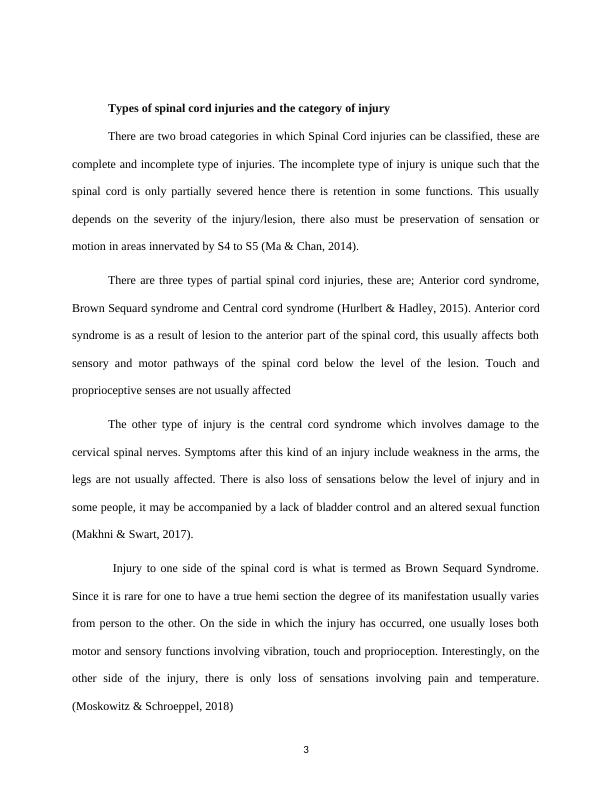Ask a question from expert
Spinal cord injuries Assignment PDF
7 Pages1732 Words100 Views
Added on 2021-06-18
Spinal cord injuries Assignment PDF
Added on 2021-06-18
BookmarkShareRelated Documents
Table of ContentsSpinal cord injuries (SCI)................................................................................................................1Introduction..................................................................................................................................1Incidence and causes................................................................................................................2Types of spinal cord injuries and the category of injury..............................................................2Australian community resource that is available for spinal cord injury patients............................4References........................................................................................................................................5Spinal cord injuries (SCI)IntroductionAn injury to the spinal cord involves a lesion to a section of the spinal cord that can beeither reversible or irreversible depending on the extent of the injury. Its typical features include:inability to have proper control of both muscles and autonomic activities in regions of the bodyinnervated by the affected region of the spinal cord. Recovery time is usually variable frompatient to patient.1

This report will clearly show the incidences and causes of spinal cord injuries in Australiaand also indicate the various causes and types of spinal cord injuries. This will also includestatistics from the Australian Spinal Cord Injury Registry (ASCIR).Incidence and causesAccording to ASCIR, 347 cases were reported during 2013-2014 with 111 resulting from non-traumatic causes and 236 from traumatic incidences (White & Black, 2016). The above statistic was from people aged above 15 years. In reference to the statistics, it also stipulated that 81% of traumatic spinal cord injuries were from the male population and an average of 23% of all the spinal cord injuries cases were sustained by people aged between 15-24 years (New & Baxter, 2015)Non-traumatic causes of spinal cord injury include disc herniation, infectious conditions,cancer, myelopathy, spinal canal stenosis and vascular disorders. These are usually managedthrough proper taking of medication in incidences where there is an infection or various surgicalprocedures to ease or correct the cause of the problem.Traumatic causes of SCI are usually not anticipated (Wilson & Voth, 2016). In Australia,ASCIR, 45% of all traumatic cases are due to land accidents. In land transport related SCI cases,motorcycle drivers accounted for almost 32% of all the cases, followed by motor vehicle drivers(23%) and motor vehicle passengers (18%). Falls contribute to 32% of all SCI cases with lowfalls contributing (17%) and high falls (15%) of all the cases. About 10% of SCI incidences werewater related (Middleton & Piccenna, 2015).2

Types of spinal cord injuries and the category of injuryThere are two broad categories in which Spinal Cord injuries can be classified, these arecomplete and incomplete type of injuries. The incomplete type of injury is unique such that thespinal cord is only partially severed hence there is retention in some functions. This usuallydepends on the severity of the injury/lesion, there also must be preservation of sensation ormotion in areas innervated by S4 to S5 (Ma & Chan, 2014).There are three types of partial spinal cord injuries, these are; Anterior cord syndrome,Brown Sequard syndrome and Central cord syndrome (Hurlbert & Hadley, 2015). Anterior cordsyndrome is as a result of lesion to the anterior part of the spinal cord, this usually affects bothsensory and motor pathways of the spinal cord below the level of the lesion. Touch andproprioceptive senses are not usually affectedThe other type of injury is the central cord syndrome which involves damage to thecervical spinal nerves. Symptoms after this kind of an injury include weakness in the arms, thelegs are not usually affected. There is also loss of sensations below the level of injury and insome people, it may be accompanied by a lack of bladder control and an altered sexual function(Makhni & Swart, 2017). Injury to one side of the spinal cord is what is termed as Brown Sequard Syndrome.Since it is rare for one to have a true hemi section the degree of its manifestation usually variesfrom person to the other. On the side in which the injury has occurred, one usually loses bothmotor and sensory functions involving vibration, touch and proprioception. Interestingly, on theother side of the injury, there is only loss of sensations involving pain and temperature.(Moskowitz & Schroeppel, 2018)3

End of preview
Want to access all the pages? Upload your documents or become a member.
Related Documents
Evidence Based Nursing Research: PDFlg...
|7
|1461
|119
What interventions must the nurse implement to prevent respiratory complications?lg...
|5
|975
|13